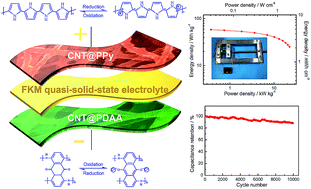Stretchable fluoroelastomer quasi-solid-state organic electrolyte for high-performance asymmetric flexible supercapacitors†
Abstract
Stretchable electrolytes are the key components to fabricate high-performance stretchable/flexible energy-storage devices, but there is little related research, especially about organic solvent-resistant types. Herein, novel stretchable fluoroelastomer/tetraethylammonium tetrafluoroborate–acetonitrile (FKM/Et4NBF4–AN), quasi-solid-state organic electrolytes were prepared by chemical cross-linking with hexamethylene diamine (HMDA). The FKM/Et4NBF4–AN quasi-solid-state electrolyte exhibited a slight plastic deformation (1.4%) after 500 stretching cycles at 100% strain, good solvent resistance, high ionic conductivity (9.9 × 10−3 S cm−1), and nonflammability. In order to demonstrate its superior performance, a novel “prestrain-stick-relax-cure-soak” assembly strategy was adopted for the organic asymmetric flexible supercapacitors (oAFSCs) with carbon nanotube paper-supported polypyrrole (CNT@PPy) and poly(1,5-diaminoanthraquinone) (CNT@PDAA) as cathode and anode, respectively. The as-assembled oAFSC achieved a high energy density of 58.2 W h kg−1 (4.87 mW h cm−3) at a power density of 0.37 kW kg−1 (0.031 W cm−3), superior cycling stability (88% retention after 10 000) and works well even in the stretched, bended or twisted state.


 Please wait while we load your content...
Please wait while we load your content...